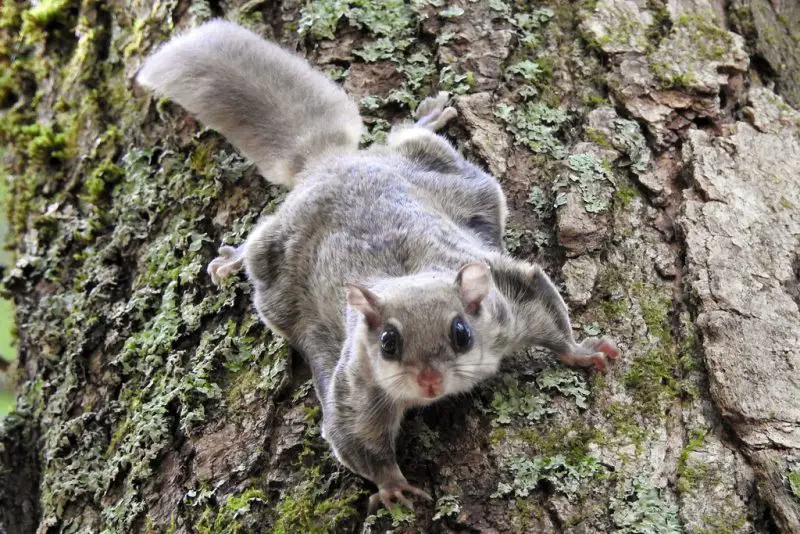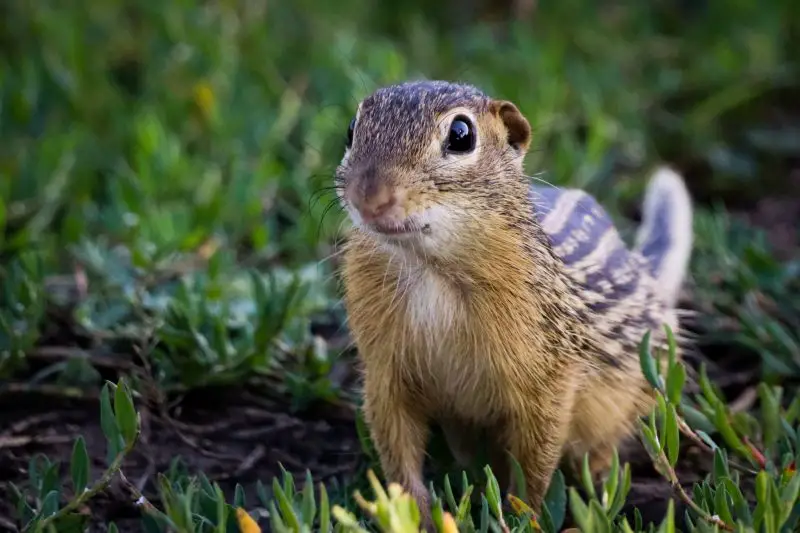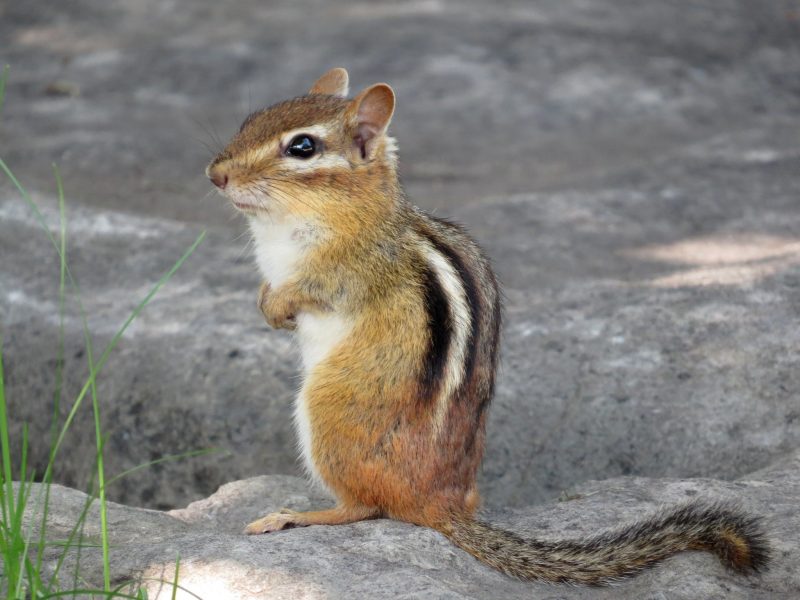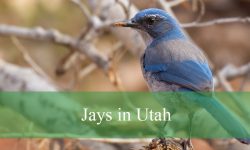If you take a walk through Missouri’s forests, fields, or even suburban neighborhoods, chances are you’ll see a squirrel darting across your path or leaping from branch to branch. These small mammals are more than just playful backyard visitors—they are an essential part of the state’s wildlife.
From the lively chatter of Eastern Gray Squirrels to the powerful digging of Woodchucks and the secret nighttime glides of Flying Squirrels, Missouri hosts a surprising variety of species. Each one has its own story, behavior, and role in shaping the natural environment.
Learning to tell these squirrels apart can make your time outdoors even more rewarding. Whether you’re a curious hiker, a birdwatcher who notices furry companions at the feeder, or someone fascinated by nature’s details, understanding Missouri’s squirrels opens the door to seeing wildlife in a whole new way.
Different Types of Squirrels Found in Missouri
Eastern Gray Squirrel (Sciurus carolinensis)

The Eastern Gray Squirrel is the most widespread squirrel species in Missouri and is commonly seen in both urban neighborhoods and wooded areas. Its fur is predominantly gray with touches of brown along the back and a lighter, whitish underside. The bushy tail, which is nearly as long as the body, helps it balance while climbing and jumping between branches. Adults typically measure 16 to 20 inches in length, including the tail, and weigh around 1 to 1.5 pounds.
This species is highly adaptable and thrives in hardwood forests, parks, and residential areas where oak, hickory, and walnut trees provide abundant food. They are primarily diurnal, with peak activity during early morning and late afternoon. Gray squirrels are strong climbers and can quickly scale trees to escape predators. Their ability to thrive around humans often makes them one of the most recognized wildlife residents in Missouri.
In terms of diet, Eastern Gray Squirrels rely heavily on nuts, acorns, seeds, fruits, and occasionally fungi or insects. They are well-known for caching food in the ground to eat later during winter. Many of these buried nuts are never retrieved, playing a crucial role in forest regeneration by helping new trees grow. Their feeding behavior significantly shapes the local ecosystem.
Eastern Gray Squirrels build leafy nests, called dreys, high in trees, although they may also occupy tree cavities when available. Breeding occurs twice a year, usually in late winter and midsummer, and litters range from two to five young. Because of their adaptability and abundance, they are often used as a symbol of Missouri’s diverse wildlife.
Fox Squirrel (Sciurus niger)

The Fox Squirrel is Missouri’s largest tree squirrel, often measuring 18 to 27 inches long including its bushy tail, and weighing up to 3 pounds. Its fur varies from reddish-brown to grayish with orange underparts, giving it a distinct appearance compared to the Eastern Gray Squirrel. The tail is thick and slightly less feathery, helping distinguish it from its smaller cousin. Their size and coloration make them easy to identify in both woodlands and open fields.
Fox Squirrels prefer open woodlots, scattered trees, and forest edges rather than dense forests. They are particularly common in areas with oak and hickory trees, where food is abundant. Compared to the gray squirrel, they are slower climbers but more comfortable on the ground, where they forage for fallen nuts and seeds. They are most active during the day and often appear in open spaces where they can be seen hopping along the ground.
Their diet consists mainly of acorns, walnuts, hickory nuts, and corn. Like gray squirrels, they also bury nuts for later use, helping distribute seeds across the landscape. In agricultural regions of Missouri, they frequently feed in cornfields during late summer and fall. Fox Squirrels also eat insects, buds, and fruits when nuts are scarce, showing a diverse and opportunistic feeding strategy.
Breeding occurs in winter and summer, with litters averaging three to four young. Fox Squirrels build large leaf nests in tree forks or occupy natural tree cavities for shelter. Their preference for more open habitats, along with their larger size and reddish coat, sets them apart as a unique and easily recognizable squirrel species in Missouri.
Southern Flying Squirrel (Glaucomys volans)

The Southern Flying Squirrel is the smallest and most elusive squirrel found in Missouri. Measuring just 8 to 10 inches long, including its tail, and weighing only 2 to 3 ounces, it is rarely seen due to its strictly nocturnal habits. Its soft fur is grayish-brown on the back with a white belly, and it has large black eyes adapted for night vision. The most distinctive feature is the loose flap of skin, called a patagium, stretching from wrist to ankle, which allows it to glide through the air.
These squirrels prefer mature hardwood forests with dense canopies that provide ideal gliding opportunities. They are most often found in areas with abundant oak, hickory, and beech trees. Unlike gray and fox squirrels, flying squirrels are rarely seen during the day, making them one of Missouri’s least-observed mammals despite being fairly common in suitable habitats.
Their diet includes a wide variety of foods such as acorns, hickory nuts, seeds, fruits, fungi, and insects. They are also known to eat bird eggs and nestlings on occasion. Like other squirrels, they store nuts in tree cavities or bury them in the ground for winter use. Because they are highly social, Southern Flying Squirrels often share nesting sites, especially during colder months, to conserve heat.
Breeding usually occurs twice a year, with litters ranging from two to seven young. Nests are typically built in tree cavities or old woodpecker holes, lined with soft materials like moss, leaves, and shredded bark. Their unique gliding ability, nocturnal lifestyle, and social nesting habits make the Southern Flying Squirrel a fascinating but often overlooked part of Missouri’s wildlife.
Woodchuck / Groundhog (Marmota monax)

The Woodchuck, often called the Groundhog, is one of the largest members of the squirrel family in Missouri. Adults typically measure 16 to 26 inches long and weigh between 4 to 14 pounds, depending on the season. Their fur is coarse and brownish-gray, with a short, bushy tail and strong claws designed for digging. The head is broad with small ears and sharp incisors that continue to grow throughout life, making them excellent gnawers.
This species prefers open fields, woodland edges, pastures, and areas near agricultural lands where food is abundant. Unlike tree squirrels, Woodchucks are strictly ground-dwelling and create extensive burrow systems that may be 30 feet long with multiple entrances. These burrows provide shelter from predators, places to rear young, and hibernation chambers for winter. Their digging activity also helps aerate soil and influences plant growth.
Woodchucks are primarily herbivores, feeding on grasses, clover, dandelions, garden crops, and other vegetation. They occasionally eat insects or small animals, but plants make up the bulk of their diet. In late summer and fall, they consume large amounts of food to build fat reserves for hibernation. During winter, they enter a deep hibernation state in their burrows, emerging again in early spring.
Breeding occurs soon after hibernation ends, with females giving birth to a litter of two to six young in underground dens. Young woodchucks stay with the mother for about two months before dispersing. Despite being considered an agricultural pest at times, Woodchucks are important in Missouri’s ecosystem, providing burrows used by other animals such as foxes, rabbits, and snakes.
Thirteen-lined Ground Squirrel (Ictidomys tridecemlineatus)

The Thirteen-lined Ground Squirrel is a small and distinctive species found in Missouri’s prairies, grasslands, and open fields. Measuring only 6 to 12 inches in length and weighing around 5 to 9 ounces, it is much smaller than tree squirrels. Its back is patterned with 13 alternating light and dark stripes running from head to tail, giving the species its name and making it easy to identify.
This species thrives in open, grassy areas with short vegetation that allows it to spot predators easily. It digs burrows that provide shelter, nesting areas, and storage for food. Unlike tree squirrels, it rarely climbs and instead relies on its speed and alertness to escape threats. It is diurnal and spends much of the day foraging in open ground before quickly darting back to its burrow when alarmed.
Thirteen-lined Ground Squirrels feed on a wide range of foods including seeds, grains, grasses, insects, and even small vertebrates. Grasshoppers, crickets, and caterpillars are particularly important in their diet during the summer months. Their varied diet makes them both beneficial for controlling insect populations and problematic when they consume crops or stored grains.
These squirrels enter hibernation in late fall and remain underground until spring. Breeding takes place shortly after they emerge, and litters average seven to ten young. Because of their abundance in grassy habitats, they are a common sight in Missouri during the warmer months, often seen standing upright near burrow entrances. Their unique striping and ground-dwelling habits set them apart from other squirrel species in the state.
Eastern Chipmunk (Tamias striatus)

The Eastern Chipmunk, while smaller than tree squirrels, is a familiar sight across Missouri. It measures about 8 to 10 inches long including its tail and weighs between 2 to 5 ounces. Its reddish-brown coat is marked with five dark stripes running down its back and two pale stripes on each side of its face. Its cheek pouches, used to transport food, are one of its most recognizable features.
Eastern Chipmunks prefer wooded areas, gardens, and suburban landscapes where cover and food sources are plentiful. They dig elaborate burrow systems with multiple chambers, including storage rooms for food and nesting sites. Unlike tree squirrels, chipmunks spend most of their time on or near the ground, although they can climb shrubs and small trees when necessary. Their burrows often remain hidden, with entrances concealed under rocks, logs, or shrubs.
Their diet is highly varied and includes acorns, seeds, berries, fruits, insects, and occasionally small bird eggs. They are especially known for collecting and storing food in their cheek pouches, transporting it back to their burrows to build reserves for winter. This caching behavior helps them survive periods of scarcity and ensures a steady food supply.
Chipmunks do not truly hibernate but enter a state of torpor during winter, waking periodically to eat stored food. Breeding occurs twice per year, in spring and summer, with litters averaging four to five young. Their energetic movements, distinctive calls, and striped patterns make them one of Missouri’s most charming and easily recognized small mammals.
Best Time and Places to Observe Squirrels in Missouri
Seasonal Activity of Squirrels
Squirrels in Missouri are most active during spring and fall, when food availability is at its peak. In spring, they are busy searching for new vegetation, buds, and insects, while fall is the critical season for storing acorns, hickory nuts, and walnuts in preparation for winter. Summer also offers plenty of opportunities to observe squirrels, though activity may slow during the hottest parts of the day. Winter sightings are less common, especially for species that hibernate, such as the Woodchuck and Thirteen-lined Ground Squirrel. Tree squirrels like the Eastern Gray and Fox Squirrels remain visible year-round, though they reduce activity during extreme cold.
Best Habitats to Find Squirrels
Missouri offers diverse habitats that support different squirrel species. Hardwood forests, especially those with oak, hickory, and walnut trees, are prime areas to observe Eastern Gray and Fox Squirrels. Urban parks and residential neighborhoods with mature trees also provide excellent opportunities for close encounters. Flying Squirrels, being nocturnal, are best observed at night using red-filtered flashlights near wooded areas. For ground squirrels like the Woodchuck and Thirteen-lined Ground Squirrel, open fields, prairies, and forest edges are the ideal spots to watch their daytime activity. Chipmunks are often found in gardens, wooded yards, and along stone walls where cover is available.
Tips for Safe and Enjoyable Observation
When observing squirrels in Missouri, patience and silence are key. Early morning and late afternoon are the best times to spot active squirrels as they forage for food. Carrying binoculars allows for a closer look without disturbing their natural behavior. For Flying Squirrels, consider setting up bird feeders in wooded areas at night, as they are often attracted to sunflower seeds and suet. If you wish to photograph squirrels, move slowly and avoid sudden noises, as these animals are quick to flee when threatened.
FAQs About Squirrels in Missouri
Are squirrels active year-round in Missouri?
Not all squirrels remain active throughout the year. Eastern Gray and Fox Squirrels are active year-round, while Woodchucks and Thirteen-lined Ground Squirrels hibernate during winter. Chipmunks enter torpor but wake periodically to eat stored food.
Where is the best place to see Flying Squirrels in Missouri?
Flying Squirrels are best observed in mature hardwood forests at night. Because they are nocturnal, using a red-filtered flashlight or setting up nighttime feeders can increase your chances of seeing them.
Do squirrels damage trees or property in Missouri?
Tree squirrels may occasionally strip bark, chew wires, or raid bird feeders, which can cause minor property damage. However, they also play an essential role in spreading tree seeds and maintaining healthy forest ecosystems.
What do most squirrels eat in Missouri?
Squirrels primarily eat nuts, acorns, seeds, fruits, and fungi. Some species, like Flying Squirrels and Chipmunks, may also consume insects, eggs, or small animals when plant food is scarce.
Can squirrels carry diseases harmful to humans?
While squirrels can carry parasites such as fleas and ticks, the risk of disease transmission to humans is relatively low. It is best not to handle wild squirrels directly to avoid potential bites or exposure.






